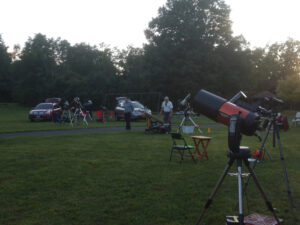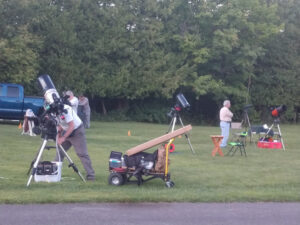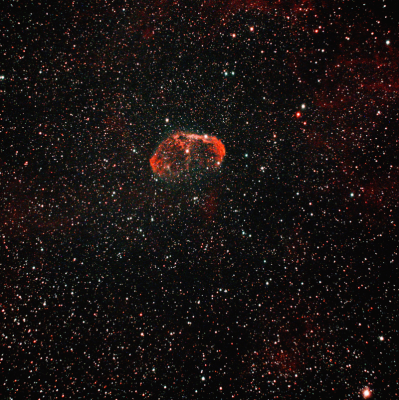At Cedar Bay in Dewitt, a whopping ten SAS members came together to volunteer their time and share their knowledge, experience, and equipment with members of our community, continuing to support our club’s mission to provide outreach and promote astronomy to the public. I believe we were successful in that endeavor last night.
The Dewitt Parks and Recreation Department donated $300 to SAS as the sole sponsor for about 50 residents of Dewitt, a suburb of Syracuse. Attendees paid $10 each to the Town to offset the cost to taxpayers. A local bakery also donated some half-moon cookies to the event. Shannon S from the Parks Dept, brought a dozen chairs and helped set up the grounds, stayed for the entire event, accepting last minute entries, and answering questions. She was a pleasure to work with, and we look forward to repeating the event next year.
Many thanks to Tony K., John R., Bob, O., Ray D., Mike F., Mike Z., and new members Tom C., Kevin L., Dan E., who joined me for the 3 hour show of lively discussions, awesome views, and some EAA under a typical suburban light dome. The night was warm, dry, nearly cloudless, windless, and nearly bug-free. All in all, it was a very pleasant Labor Day Weekend evening.
Everyone spaced themselves out across the quarter acre of parkland and attracted dozens of interested folks to their stations. Target ranged from Moon, Planets, clusters and bright nebulae. I formed a small amphitheater of 8 chairs around my EAA table, and I displayed colorful targets every few minutes onto a large computer monitor and laptop for all to see. There were plenty of questions from residents who ranged in age from 20-somethings to seniors. My program started with a single star, and progressed to a double star, then to an open cluster, a few globular clusters, some galaxies and finally the Andromeda galaxy cluster using a light-pollution filter. Then I switched filters and showed many colorful nebulae…of the planetary, emission, reflection, dark, and diffused varieties. Besides enjoying the pretty pictures, I hope my audience learned something, too.
John R had quite a number of people come by to look through the scope. He started with the Moon then moved onto Albireo to show the contrasting star colors and then to M31. At one point looking at M31 he overheard Jeff mention he was going to slew to it. It gave him the opportunity to show the object visually and then send them to Jeff to see what it looks like with a little EAA.
John says he got lucky with the placing of his scope as the moment Jupiter made it above the trees he was the first one that could see it on the lawn. he had quite a number of people amazed at seeing the four Galilean moons, (until one of the moons disappeared behind the planet) as well as the bands of Jupiter. The nice thing about the Mak being so portable is that when Jupiter moved behind another large tree he could easily move the scope and get it right back for additional people to enjoy.
Mike F. had his Newtonian out and even before he aligned his digital setting circles people were coming up. Mike parked on Saturn most of the night as he had a steady stream of viewers ohhing and ahhhing at the view. He then ended up slewing to M57 and got to talk a bit about nebulas and how the Ring formed.
Brand-new member, Tom C. manned the raffle station and collected $80 (and more importantly, email addresses) for our donated prize… a gently used, 4.5″ Newtonian and 2 eyepieces on a manual equatorial mount…valued at around $200. At 10:45, a winner was randomly chosen. Several members showed her how to use it, and helped her put it into her car. She was a very happy camper.
One of the funnier moments was when astrophotographer Bob O. “discovered” EAA and was amazed at the detail he could get in just a short time.




